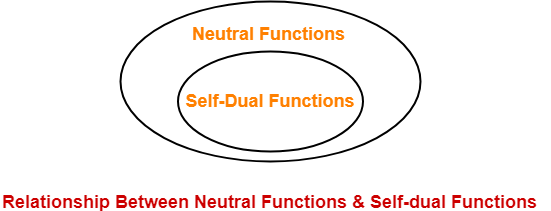Dual Of Boolean Expression-
To get a dual of any Boolean Expression, replace-
- OR with AND i.e. + with .
- AND with OR i.e. . with +
- 1 with 0
- 0 with 1
Dual of Boolean Expression Examples-
Following are examples of dual of Boolean Expressions-
Example-01:
- Consensus theorem is xy + x’z + yz = xy + x’z
- Dual of Consensus theorem is (x + y)(x’ + z)(y + z) = (x + y)(x’ + z)
Example-02:
- Boolean expression is xyz + x’yz’ + y’z = 1
- Dual of the above Boolean expression is (x + y + z)(x’ + y + z’)(y’ + z) = 0
Self-Dual Functions-
| When a function is equal to its dual, it is called as a Self dual function. |
Example-
Consider the function : F (A , B , C) = AB + BC + CA
The dual of this function is-
Fd (A , B , C)
= (A + B)(B + C)(C + A)
= AB + BC + CA
Clearly, F (A , B , C) = Fd (A , B , C)
∴ F (A , B , C) is a self-dual function.
Conditions For Self-Dual Function-
The necessary and sufficient conditions for any function to be a self-dual function are-
- The function must be a Neutral Function.
- The function must not contain any mutually exclusive terms.
Mutually Exclusive Terms
Consider we have any term X consisting of some variables. Then, a term obtained by complementing each variable of term X is called as its mutually exclusive term.
Examples-
|
Number of Self-Dual Functions-

Here n = number of Boolean variables in the function.
Explanation-
- For a function to be a self-dual function, the function must be a neutral function.
- For a function to be a neutral function, number of minterms must be equal to number of maxterms.
- So, we choose half of the terms i.e. 2n / 2 = 2n-1 terms.
- Now, for each of these terms, we have two choices whether to include it or not in the self-dual function.
So, possible number of self-dual functions
= 2 x 2 x 2 x ……. x 2n-1
= 22^(n-1)
Relationship Between Neutral Functions & Self-dual Functions-
- Every self-dual function is surely a neutral function.
- But every neutral function need not be a self-dual function.

Important Property of Self-Dual Functions-
| Self-duality is closed under complementation. |
Example-
- If the function F (A , B , C) = ∑ (0 , 1 , 2 , 4) is a self-dual function.
- Then, its complement function F’ (A , B , C) = ∑ (3 , 5 , 6 , 7) will also be a self-dual function.
PRACTICE PROBLEM BASED ON SELF-DUAL FUNCTIONS-
Problem-
Consider the following functions-
- F (A , B , C) = ∑ (0 , 2 , 3)
- F (A , B , C) = ∑ (0 , 1 , 6 , 7)
- F (A , B , C) = ∑ (0 , 1 , 2 , 4)
- F (A , B , C) = ∑ (3 , 5 , 6 , 7)
Which of the above functions are self-dual functions?
- Only (iii)
- Only (ii)
- Only (iii) and (iv)
- All are self-dual functions
Solution-
Condition-01:
According to condition-01, for a function to be a self-dual function, the function must be a neutral function.
- In all the given options, we have functions of 3 variables- A, B and C.
- So, Neutral function must contain exactly 2n-1 = 23-1 = 4 minterms and 4 maxterms.
- But Function-(i) contains only 3 minterms. So, it is not a neutral function.
- Therefore, it can’t be a self-dual function and it gets eliminated.
- We are now left with three other functions which satisfies condition-01 and are all neutral functions.
- We will now use 2nd condition to eliminate the incorrect option(s).
Condition-02:
According to condition-02, a self-dual function must not contain mutually exclusive terms.
First, let us find which terms are mutually exclusive-
| A | B | C | Minterms | |
| 0 | 0 | 0 | 0 | A’B’C’ |
| 1 | 0 | 0 | 1 | A’B’C |
| 2 | 0 | 1 | 0 | A’BC’ |
| 3 | 0 | 1 | 1 | A’BC |
| 4 | 1 | 0 | 0 | AB’C’ |
| 5 | 1 | 0 | 1 | AB’C |
| 6 | 1 | 1 | 0 | ABC’ |
| 7 | 1 | 1 | 1 | ABC |
- From here, pairs of mutually exclusive terms are (0,7) , (1,6) , (2,5) , (3,4).
- Mutually exclusive terms are not allowed in self-dual functions.
- Therefore, terms inside the pairs can not appear together.
- But terms 0 and 7 appear together in the function-(ii).
- So, it can not be a self-dual function.
- But functions (iii) and (iv) do not contain any mutually exclusive terms.
- Therefore, functions (iii) and (iv) are self-dual functions.
Thus, Option (C) is correct.
NOTE-
- Functions (iii) and (iv) are complementary functions.
- So, if one function is a self-dual function, the other function will also be a self-dual function.
- This is because self-dual functions are closed under complementation.
To gain better understanding about Self-Dual Functions,
Get more notes and other study material of Digital Design.
Watch video lectures by visiting our YouTube channel LearnVidFun.